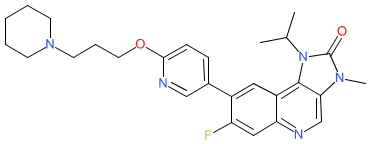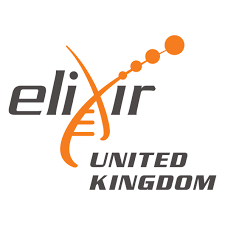GtoPdb is requesting financial support from commercial users. Please see our sustainability page for more information.
|
Compound class:
Synthetic organic
Comment: AZD1390 is an oral, brain-penetrant ATM kinase inhibitor [2]. Structurally, AZD1390 is from the same chemical series as AZD0156, but is optimised to cross the blood-brain barrier [3-4]. Mechanistically, blocking ATM disrupts DNA damage repair and sensitises cancer cells to radiotherapy. This induces G2 cell cycle arrest and the development of micronuclei, and ultimately leads to apoptosis. Experimental evidence suggests that AZD1390 is able to promote neurite outgrowth in vitro, and axon regeneration and functional recovery in in vivo models of spinal cord injury [1].
Ligand Activity Visualisation ChartsThese are box plot that provide a unique visualisation, summarising all the activity data for a ligand taken from ChEMBL and GtoPdb across multiple targets and species. Click on a plot to see the median, interquartile range, low and high data points. A value of zero indicates that no data are available. A separate chart is created for each target, and where possible the algorithm tries to merge ChEMBL and GtoPdb targets by matching them on name and UniProt accession, for each available species. However, please note that inconsistency in naming of targets may lead to data for the same target being reported across multiple charts. ✖ |
|
|||||||||||||||||
| References |
|
1. Ahmed Z, Tuxworth RI. (2022)
The brain-penetrant ATM inhibitor, AZD1390, promotes axon regeneration and functional recovery in preclinical models of spinal cord injury. Clin Transl Med, 12 (7): e962. [PMID:35818848] |
|
2. Durant ST, Zheng L, Wang Y, Chen K, Zhang L, Zhang T, Yang Z, Riches L, Trinidad AG, Fok JHL et al.. (2018)
The brain-penetrant clinical ATM inhibitor AZD1390 radiosensitizes and improves survival of preclinical brain tumor models. Sci Adv, 4 (6): eaat1719. [PMID:29938225] |
|
3. Jucaite A, Stenkrona P, Cselényi Z, De Vita S, Buil-Bruna N, Varnäs K, Savage A, Varrone A, Johnström P, Schou M et al.. (2021)
Brain exposure of the ATM inhibitor AZD1390 in humans-a positron emission tomography study. Neuro Oncol, 23 (4): 687-696. [PMID:33123736] |
|
4. Talele S, Zhang W, Chen J, Gupta SK, Burgenske DM, Sarkaria JN, Elmquist WF. (2022)
Central Nervous System Distribution of the Ataxia-Telangiectasia Mutated Kinase Inhibitor AZD1390: Implications for the Treatment of Brain Tumors. J Pharmacol Exp Ther, 383 (1): 91-102. [PMID:36137710] |






